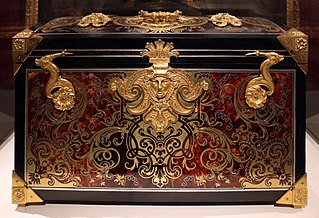
Marquetry is the art and craft of applying pieces of veneer to a structure to form decorative patterns, designs. The technique may be applied to case furniture or even seat furniture, to decorative small objects with smooth, veneerable surfaces or to freestanding pictorial panels appreciated in their own right.

Joinery is a part of woodworking that involves joining pieces of wood, engineered lumber, or synthetic substitutes, to produce more complex items. Some woodworking joints employ mechanical fasteners, bindings, or adhesives, while others use only wood elements.

Thomas Chippendale (1718–1779) was a cabinet-maker in London, designing furniture in the mid-Georgian, English Rococo, and Neoclassical styles. In 1754 he published a book of his designs in a trade catalogue titled The Gentleman and Cabinet Maker's Director—the most important collection of furniture designs published in England to that point which created a mass market for furniture—upon which success he became renowned. According to the Victoria and Albert Museum, "so influential were his designs, in Britain and throughout Europe and America, that 'Chippendale' became a shorthand description for any furniture similar to his Director designs".

Carpentry is a skilled trade and a craft in which the primary work performed is the cutting, shaping and installation of building materials during the construction of buildings, ships, timber bridges, concrete formwork, etc. Carpenters traditionally worked with natural wood and did rougher work such as framing, but today many other materials are also used and sometimes the finer trades of cabinetmaking and furniture building are considered carpentry. In the United States, 98.5% of carpenters are male, and it was the fourth most male-dominated occupation in the country in 1999. In 2006 in the United States, there were about 1.5 million carpentry positions. Carpenters are usually the first tradesmen on a job and the last to leave. Carpenters normally framed post-and-beam buildings until the end of the 19th century; now this old-fashioned carpentry is called timber framing. Carpenters learn this trade by being employed through an apprenticeship training—normally four years—and qualify by successfully completing that country's competence test in places such as the United Kingdom, the United States, Canada, Switzerland, Australia and South Africa. It is also common that the skill can be learned by gaining work experience other than a formal training program, which may be the case in many places.
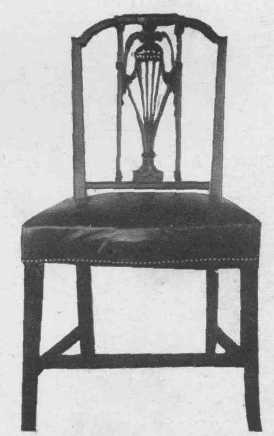
Thomas Sheraton was a furniture designer, one of the "big three" English furniture makers of the 18th century, along with Thomas Chippendale and George Hepplewhite. Sheraton gave his name to a style of furniture characterized by a feminine refinement of late Georgian styles and became the most powerful source of inspiration behind the furniture of the late 18th century.
George Hepplewhite was a cabinetmaker. He is regarded as having been one of the "big three" English furniture makers of the 18th century, along with Thomas Sheraton and Thomas Chippendale. There are no pieces of furniture made by Hepplewhite or his firm known to exist but he gave his name to a distinctive style of light, elegant furniture that was fashionable between about 1775 and 1800 and reproductions of his designs continued through the following centuries. One characteristic that is seen in many of his designs is a shield-shaped chair back, where an expansive shield appeared in place of a narrower splat design.
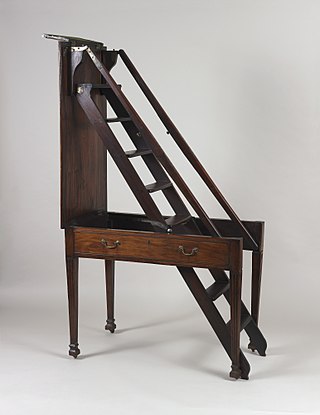
Metamorphic library steps are a type of archaic dual-use furniture, consisting of a small folding staircase that can be transformed into chair or desk form. In desk form, it can also be considered a mechanical desk.

A commode is any of many pieces of furniture. The Oxford English Dictionary has multiple meanings of "commode". The first relevant definition reads: "A piece of furniture with drawers and shelves; in the bedroom, a sort of elaborate chest of drawers ; in the drawing room, a large kind of chiffonier." The drawing room is itself a term for a formal reception room, and a chiffonier is, in this sense, a small sideboard dating from the early 19th century.
Chairs are known from Ancient Egypt and have been widespread in the Western world from the Greeks and Romans onwards. They were in common use in China from the twelfth century, and were used by the Aztecs. In Sub-Saharan Africa, chairs were not in use before introduction by Europeans.

Thomas Shearer was an 18th-century English furniture designer and cabinet-maker.
Campaign furniture is a type of furniture which is made for travel. Historically, much of it was made for military campaigns.

Sheraton is a late 18th-century Neoclassical English furniture style, in vogue c. 1785–1820, that was coined by 19th-century collectors and dealers to credit furniture designer Thomas Sheraton, whose books, The Cabinet Dictionary (1803) of engraved designs and the Cabinet Maker's & Upholsterer's Drawing Book (1791) of furniture patterns exemplify this style.
An ébéniste is a cabinet-maker, particularly one who works in ebony. The term is a loanword from French and translates to "ebonist".
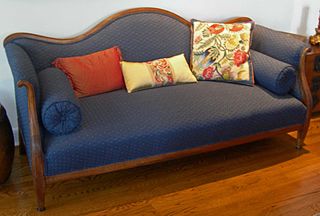
A lyre arm is an element of design in furniture, architecture and the decorative arts, wherein a shape is employed to emulate the geometry of a lyre; the original design of this element is from the Classical Greek period, simply reflecting the stylistic design of the musical instrument. One of the earliest uses extant of the lyre design in the Christian era is a 6th-century AD gravestone with lyre design in double volute form. In a furniture context, the design is often associated with a scrolling effect of the arms of a chair or sofa. The lyre arm design arises in many periods of furniture, including Neoclassical schools and in particular the American Federal Period and the Victorian era. Well known designers who employed this stylistic element include the noted New York City furniture designer Duncan Phyfe.
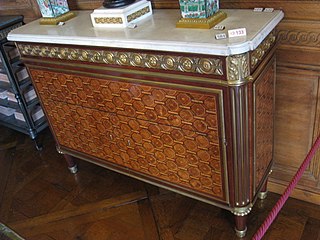
French furniture comprises both the most sophisticated furniture made in Paris for king and court, aristocrats and rich upper bourgeoisie, on the one hand, and French provincial furniture made in the provincial cities and towns many of which, like Lyon and Liège, retained cultural identities distinct from the metropolis. There was also a conservative artisanal rural tradition of French country furniture which remained unbroken until the advent of the railroads in the mid-nineteenth century.
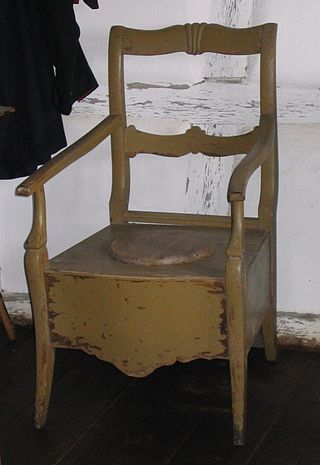
A close stool was an early type of portable toilet, made in the shape of a cabinet or box at sitting height with an opening in the top. The external structure contained a pewter or earthenware chamberpot to receive the user's excrement and urine when they sat on it; this was normally covered (closed) by a folding lid. "Stool" has two relevant meanings: as a type of seat and as human feces. Close stools were used from the Middle Ages until the introduction of the indoor flush toilet.
John McLean was an English furniture and cabinetry maker and designer. He was recognized as one of the best of his era, representing the best in English cabinetmaking. Examples of his furniture can be found in the Victorian and Albert Museum, The California Palace of the Legion of Honor and the Library at Saltram, Devon.

A cabinet is a case or cupboard with shelves and/or drawers for storing or displaying items. Some cabinets are stand alone while others are built in to a wall or are attached to it like a medicine cabinet. Cabinets are typically made of wood, coated steel, or synthetic materials. Commercial grade cabinets usually have a melamine-particleboard substrate and are covered in a high pressure decorative laminate, commonly referred to as Wilsonart or Formica.

Gillows of Lancaster and London, also known as Gillow & Co., was an English furniture making firm based in Lancaster, Lancashire, and in London. It was founded around in Lancaster in about 1730 by Robert Gillow (1704–1772).
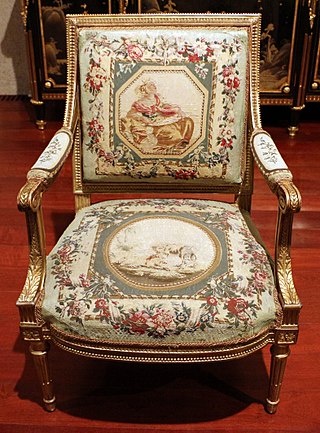
Jean-Baptiste-Claude Séne (1747-1803) was a French furniture maker in the 18th century, primarily during the reign of Louis XVI. He came from a noted family of menuisiers, or furniture craftsmen. cabinet makers. His grandfather Jean established a workshop, which was inherited by his father Claude I (1724-1792), who earned the title of a master craftsman in 1743, and made chairs and armchairs for Louis XV. Jean-Baptiste-CLaude became a master in 1769. His younger brother, Claude II, also became a master in 1769, and both made chairs for Louis XVI.